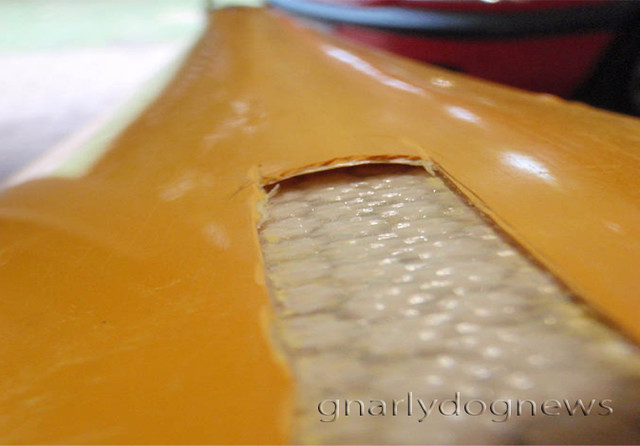Well established businesses that have been around for a long time owe their success to a number of factors but, in this small tightly-knit community of skilled kayakers, one very important aspect of retail is customer service.
It seems that aggressive advertising can lead to a healthy customer base too since often paddlers are willing to give the "new guy in town" a go.
The initial success however must be backed by a solid customer service or the buyer has the same security of purchasing gear as on eBay.

Photo: Arden
As an avid consumer of outdoor gear I have purchased (way) more than the average share of equipment throughout the years.
I do my shopping locally, if I can (if the desired items are available for a reasonable comparable price), or I shop online to source the exotic equipment that most local retailer have not heard of.
When purchasing online I buy almost exclusively from trusted vendors that offer a serious warranty policy: if it does fail they will replace it, unconditionally.
Wow! Is that true: unconditional guarantee? How can that be possible? How can they stay in business? one might ask...
The concept of an unconditional guarantee was pioneered in USA by LL Bean in 1912.
Unthinkable at the time, he started to offered unconditional warranty replacement on items that he sold in his store. The concept was so progressive that naysayers were convinced he would be bankrupt in very short time.
Well, his retail concept worked and against all odds he became very successful.
Many vendors followed his idea and equally succeeded including now the biggest retailer of outdoor gear in the world: REI.
This policy incites me to have no reservations purchasing from a retailer that genuinely backs its products by a warranty that can be claimed when things fail.
Unfortunately not all items that I purchase are from these vendors since some highly specialized gear is not main stream and is available from only selected retailers that don't have this policy.
I have purchased several items that I wished were sourced from vendors that would back up faulty equipment.
I have noticed a recent increase in dissatisfaction from local and interstate paddlers with the purchase of some British boats. Several high end kayaks have displayed problems in manufacturing ranging from poorly assembled decks, hulls and coamings to problems in the laminate.
I had my share of bubbles in the gel coat where the fibreglass was not laid out carefully in the factory but I repaired those voids myself without inconveniencing the retailer of the kayak or the manufacturer. I did not have to and I could have had it done professionally and billed the retailer.

laminate problem on the keel line
I had also a couple of imported kayaks that had problems with the construction of the laminate and could not be repaired to a satisfactory level. I had to negotiate a deal with the manufacturer and eventually had those kayaks replaced.
I am also aware of the same laminate problem on a kayak in Tasmania and the customer has never had the kayak replaced. He is stuck with a kayak that is faulty.
Several other customers have come forward with faults on their kayaks.
Some problems were rectified by the owners of those kayaks but in too many cases the retailer has simply washed his hands of the problem.
High end sea kayaking retailing is based on repeated custom or word-of-mouth advertising; poor customer service is giving these retailers a bad reputation and is very damaging.
While their business seems to be still thriving now, eventually it will suffer.
They are not dealing with teenagers that assume faulty equipment is just the nature of the product: cheap and with a short lifespan.
Sea kayakers are demographically more mature and value good after sale service; failing them is shortsighted.
 |
| photo: Chris Walker . |



Yes Damiano, that is truly the key to success in today's world. Things happen but it is how prepared you are to handle the issues swiftly that will differentiate between a mediocre vendor and an exceptional one.
ReplyDeletePaul
Just a thought. Bigger companies have more staff and more chance of not knowing what corners that staff member may take. I certainly assumed that an apprentice or a worker in a hurry must have put the silicon where the skeg cable goes into the day hatch when I actually placed a small mirror in the hatch and took a look at the spaghetti like work. It was easy to see why water poured into the day hatch.
ReplyDeleteFollowing my online conversations I had with GDN readers I would like to point out that reality is that stuff happens and it does.
ReplyDeleteThings break because of poor workmanship or lousy design, cracks occur during transport when kayaks are mishandled in the warehouses, fabric of garments fall apart because of a bad batch, paddle joiners wear out prematurely.. the list is extensive.
While some products are better than others faults can occur in all of them; it is how the retailer handles the problems that is important thou.
I had one extremely bad experience where the manager of a store belittled me and lied about a product just to win his argument (later on he was presented with evidence from the manufacturer that he was making false claims). The item was replaced under warranty but I made sure I never shopped in that store again.
There is no reason why a retailer should bully the customer, never.
In a previous post I also mentioned the chauvinistic attitude of some retailers towards women to the point that some female customers no longer wish to deal with those retailers.
I feel that the local market has a lot of work to do to match some overseas retailing policies.